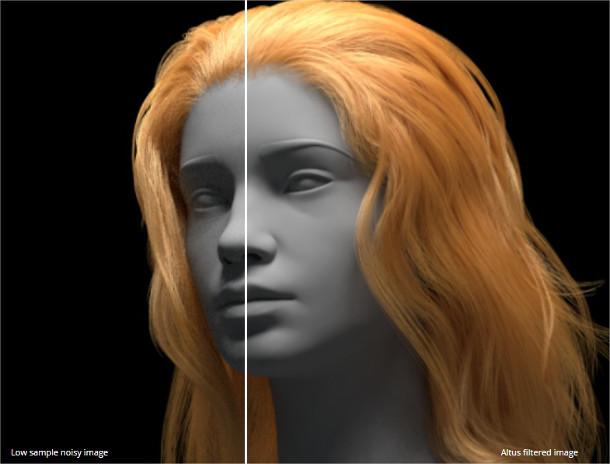innoBright halves price of Altus 1.3
Originally posted on 8 January 2016. Scroll down for news of the Altus 1.3 release and price cut.
innoBright Technologies has released Altus 1.2, the latest update to its interesting tool for denoising images generated in a range of common renderers, including Arnold, V-Ray, Corona and Redshift.
The update improves Altus’s handling of EXRs and standardises the software’s pricing.
Generate quick, noisy renders, then clean them up in post
Launched last fall, the software works along similar lines to the Denoise option introduced in RenderMan 20: in this case, automatically removing noise from raytraced images generated using Monte Carlo methods.
Users generate two fast, noisy source images, each composed of six standard passes (beauty, normal, albedo and so on) in their chosen renderer, then run Altus as a post-process to create a single clean image.
According to innoBright, this combined rendering and post-processing workflow acclerates Monte Carlo renders by 200-1,200% over simply generating an equivalently noise-free image in the host render engine.
The software can handle depth of field and motion blur, and supports both still renders and animations.
Better handling of EXRs, under-the-hood improvements
The changes in Altus 1.2 are mainly under the hood: handling of alpha channels and filtering has been “completely rewritten” and innoBright has “fixed tons of bugs”.
However, handling of EXRs has also been improved: Altus now supports 32-bit floating-point precision, can write tiled EXRs, and preserves header information, so output EXRs have the same headers as the source files.
Pricing and availability
Altus 1.2 is available for 64-bit Ubuntu 14.04 LTS or CentOS 6.x Linux and Windows. It’s OpenCL-based, so to run it, you’ll need the OpenCL run-time libraries installed.
The software is rental-only. Prices are listed at the foot of this story. A single licence lets you use any of the three Windows and Linux builds.
In addition, the integration scripts (for Maya/Arnold and Maya/V-Ray, plus a script for 3ds Max/V-Ray created by Chaos Group) are now available free, albeit without tech support available for them.
According to innoBright: “They are intended to be suggestions for integrating Altus in your rendering pipeline.”
If you want to try before you buy, there are free trial editions available: the previously “oppressive” watermark they add to output images has been made less conspicuous in version 1.2.
Updated 3 March: innoBright has just released Altus 1.3. The update doesn’t add a lot of new functionality, but it does include a beta build of the software compatible with CUDA GPUs as well as OpenCL.
In addition, Altus now automatically chooses the card with the most memory in multi-GPU set-ups, and switches to CPU mode if a failure occurs in GPU mode, ensuring that images filter to completion.
Updated 23 March: innoBright has halved the price of Altus. Node-locked licences now start at $20/month and floating licences start at $25/month

